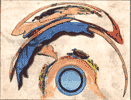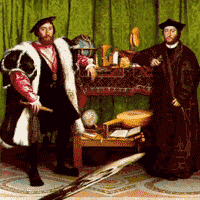Anamorphic deformation
An anamorphic image appears distorted, because it is constructed on an elongated grid, rendering it unintelligible until it is viewed from a specific, extremely oblique point of view or reflected in a curved mirror, or with some other optical device. “Anamorphosis” is a Greek word meaning transformation, or more literally “formed again.” Road signs such as “SCHOOL CROSSWALK”, maximum speed marks and directional arrows are everyday examples of anamorphical designs. Stretched out when painted on a road surface, the signs are easily understood by the drivers who must view them obliquely.


The Magic Mirror is an optical toy. The tubular mirror is placed verticaly in the center of the blue circle and then when the reflected design is viewed in the mirror the hidden picture is revealed.
In the early Renaissance period, European artists began to master perspective, becoming fascinated by the simplest kind of anamorphic art: stretched pictures seen accurately when viewed at a sharp angle. The first known examples are in Leonardo da Vinci’s notebooks; he was one of the earliest contributors to this geometry of perspective.
Hans Holbein’s portrait of Jean de Dinteville and Georges de Selves, prominent figures at the court of Henry VIII, is among the most famous examples of anamorphic painting technique. In anamorphic painting, the artist constructs the image based on one or more eccentric points of view, so as to embed an element or elements which are not discernible without the use of distorting mirrors, or unless viewed from a specific position.


In “The Ambassadors,” the brown-gray smear near the bottom of the painting is revealed to be a very realistic human skull when the painting is viewed from a point just above the top-right corner. The classic interpretation of the skull is that it marks the painter’s ironic commentary on the vanitas of Renaissance science and art, represented by the finery of the men’s costumes, and the many artistic and scientific tools and artifacts displayed on the table between them.
Holbein’s painting figures prominently in Jacques Lacan’s seminar on The Four Fundamental Concepts of Psychoanalysis; it appears on the cover of the 1973 French edition.
Lacan uses the Holbein painting to illustrate the split – the Freudian Spaltung – induced by the encounter of a signifier with the real. In Lacan’s ontology of the subject, this traumatic encounter precipitates the subject in relation to the eccentric object-cause. (It may help to think of the subject as a form approaching the split from the side of the signifier, and the object-cause as a form approaching the split from the side of the real, thus only cognizable by the subject in fantasy.) In the field of the visible, this object-cause takes the form Lacan calls the “gaze,” our fleeting awareness of an eye which seems to look back, watching us, as it were, from outside the field of vision.
In Lacan’s interpretation, the skull-blot of the Holbein portrait signifies the fundamental relation of obliquity upon which the subject’s assertion of its existence is sustained, even though the subject is incapable of cognizing that relation (Four Fundamental Concepts, 88–89.) In this sense, the distorted skull is the residual trace of a species of knowledge which is impossible for the conscious subject, and which may be approached only at the boundary of the visual-imaginary order of subjectivity.
Sources:
Terry Harpold, Department of English University of Florida
www.nwe.ufl.edu/~tharpold/resources/holbein
Pia Høy, The Anamorphosis
www.artborder.com/anamorph.html#Note1
Lacan, Jacques. The Four Fundamental Concepts of Psychoanalysis. Trans. Alan Sheridan. New York: Norton, 1981.
Baltrusaitis, Jurgis. Anamorphic Art. Trans. W.J. Strachan. New York: Harry N. Abrams, 1983.
Masters of Deception: Escher, Dalí & the Artists of Optical Illusion
http://neuro.caltech.edu/~seckel/mod/anamorph.htm#